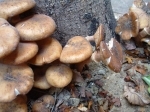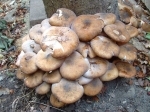
Photos ©2005–
Click any photo for a larger image


Photos ©2005–
Click any photo for a larger image

Honey Fungus - Armillaria mellea
Family - Physalacriaceae
A distinctive large fleshy parasitic fungi found on and around stumps of both broad leaved and coniferous trees, by the time the fruiting bodies are seen the trees are dying and it can do a lot of damage to woodland areas. Very common, it can be found over most of the UK and throughout mainland Europe, north America and other parts of the world. In the UK it will usually be seen from June through to November.
The cap is a light to chocolate brown colour, convex when young gradually flattening, 4–15cm (1.6–6in) on a 6–15cm (2.4–6in) tall slightly tapering stem with a ring approximately one quarter the way down from the top, gills are white when young gradually turning brown with age. The cap splits and tears as it ages. Honey fungus spreads by spores in the air germinating on damaged or dead wood. It has a second growth regime where it spreads by black or brown roots called rhizomorphs consisting of a bunch of mycelial thread like filaments that infect other plants by latching onto their roots and taking away water and nutrients. It apparently is especially partial to Oak.
It is now generally considered that Honey Fungus consists of several distinct species that have been grouped together within the Armillaria mellea epithet. They are similar in general appearance but need further examination of their macroscopic features to determine the species. They include –
These are otherwise similar to A. mellea which is the type species of the genus Armillaria.
Its name is derived from the Latin "Armillaria" meaning "scaly" and "mellea" from "mel" for Honey. Honey fungus can spread many meters from the original infected plant. One species in America – A. ostoyae is believed to be the largest living organism on earth, growing in the Malheur National Forest in East Oregon, it is reputed to be 3.5 miles across.
BCP do not advise or recommend that Honey Mushroom – Armillaria mellea is eaten or used as an herbal remedy. In the past Honey fungus was considered edible when thoroughly cooked but members of the honey fungus group are regarded as suspect.
Site design ©1999– Brickfields Country Park - Privacy -